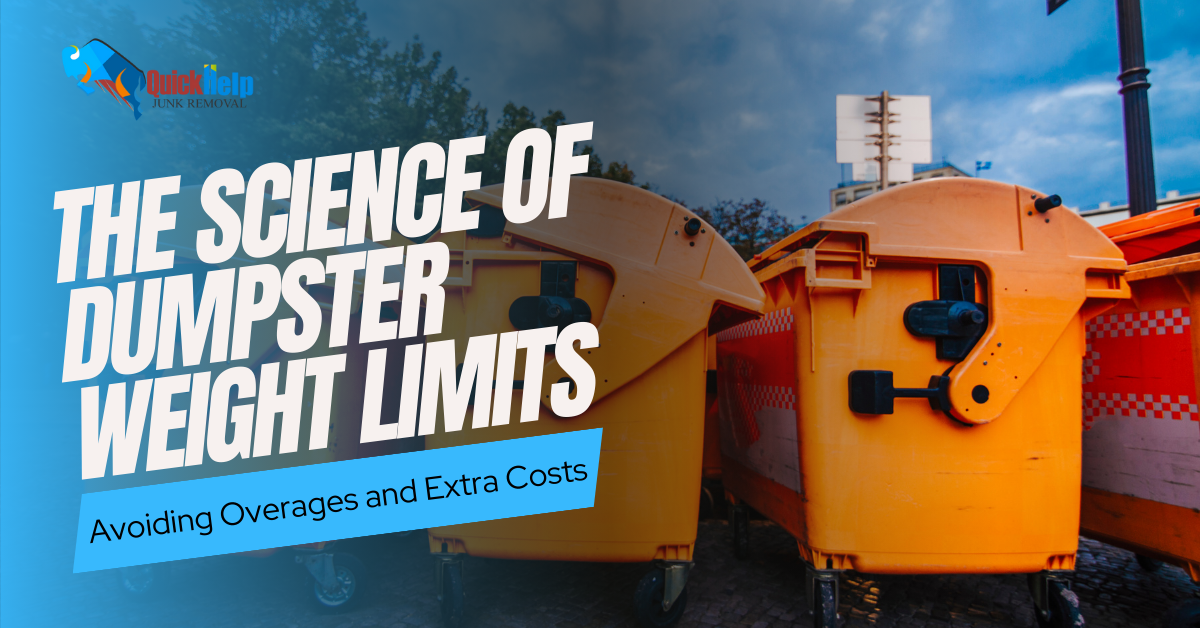Science of Dumpster Weight Limits
The Science of Dumpster Weight Limits. When it comes to junk removal and managing waste, renting a dumpster can be a lifesaver. Whether you’re tackling a home renovation project, cleaning out your garage, or dealing with a large-scale commercial cleanout, having a dumpster on-site makes the process much more manageable. However, there’s more to renting a dumpster than meets the eye. Understanding dumpster weight limits is crucial to avoid overages and extra costs. In this article, we’ll delve into the science behind these weight limits and provide you with valuable tips on how to stay within them.
Why Dumpster Weight Limits Matter
Dumpster weight limits are set for a reason. They are designed to ensure safe transportation and disposal of waste materials. When you exceed the specified weight limit for your dumpster, it can lead to various issues, including:
Safety Concerns: Overloaded dumpsters can become unstable, posing a risk to anyone nearby.
Road Damage: Excess weight can damage roads, driveways, and other surfaces when the dumpster is transported.
Environmental Impact: Overloaded dumpsters might not be properly disposed of, leading to environmental concerns.
Types of Dumpster Weight Limits
Dumpsters come in various sizes and weight limits. The most common types of dumpster weight limits include:
Gross Weight Limit: This is the total weight limit of the dumpster, including the weight of the dumpster itself and its contents. It’s important not to exceed this limit.
Per-Ton Weight Limit: Some rental companies set weight limits based on the number of tons included in the base price. You’ll pay extra fees for each ton exceeding this limit.
Estimating Your Waste Weight
To avoid exceeding weight limits, you need to estimate the weight of your waste accurately. Here are some tips:
Use Online Calculators: Many dumpster rental websites offer calculators to estimate the weight of common items. Use these tools as a starting point.
Weigh Smaller Loads: If possible, weigh smaller loads of waste on a bathroom scale and extrapolate to estimate the total weight.
Consult the Rental Company: Don’t hesitate to contact the rental company for guidance on estimating the weight of your waste.
Distribution of Weight
Properly distributing the weight of your waste inside the dumpster is essential. Distribute heavy items evenly to prevent overloading one side of the dumpster, which can lead to tipping hazards and excess weight on one axle during transport.
Recycle and Donate
Consider recycling or donating items that are still in usable condition. By reducing the volume of waste going into the dumpster, you can stay within weight limits more easily.
Be Cautious with Construction Debris
Construction debris, such as concrete, bricks, or drywall, can quickly add up in weight. Ensure that you have a clear understanding of how much these materials weigh and plan your dumpster rental accordingly.
Communication with the Rental Company
Effective communication with the dumpster rental company is key. Discuss your project’s scope and materials with them to ensure you rent a dumpster with an appropriate weight limit.
Avoiding Overages
Exceeding weight limits can result in costly overage charges. To avoid these, it’s better to err on the side of caution when estimating your waste weight and consider renting a larger dumpster with a higher weight limit if necessary.
Conclusion
Renting a dumpster can make waste removal and junk disposal a breeze, but it’s crucial to understand and respect the dumpster’s weight limits. By estimating your waste weight accurately, distributing the weight properly, and communicating effectively with the rental company, you can ensure a smooth and cost-effective junk removal process. Remember, it’s not just about staying within the limits; it’s about protecting safety, the environment, and your wallet. So, the next time you rent a dumpster, keep the science of weight limits in mind.




